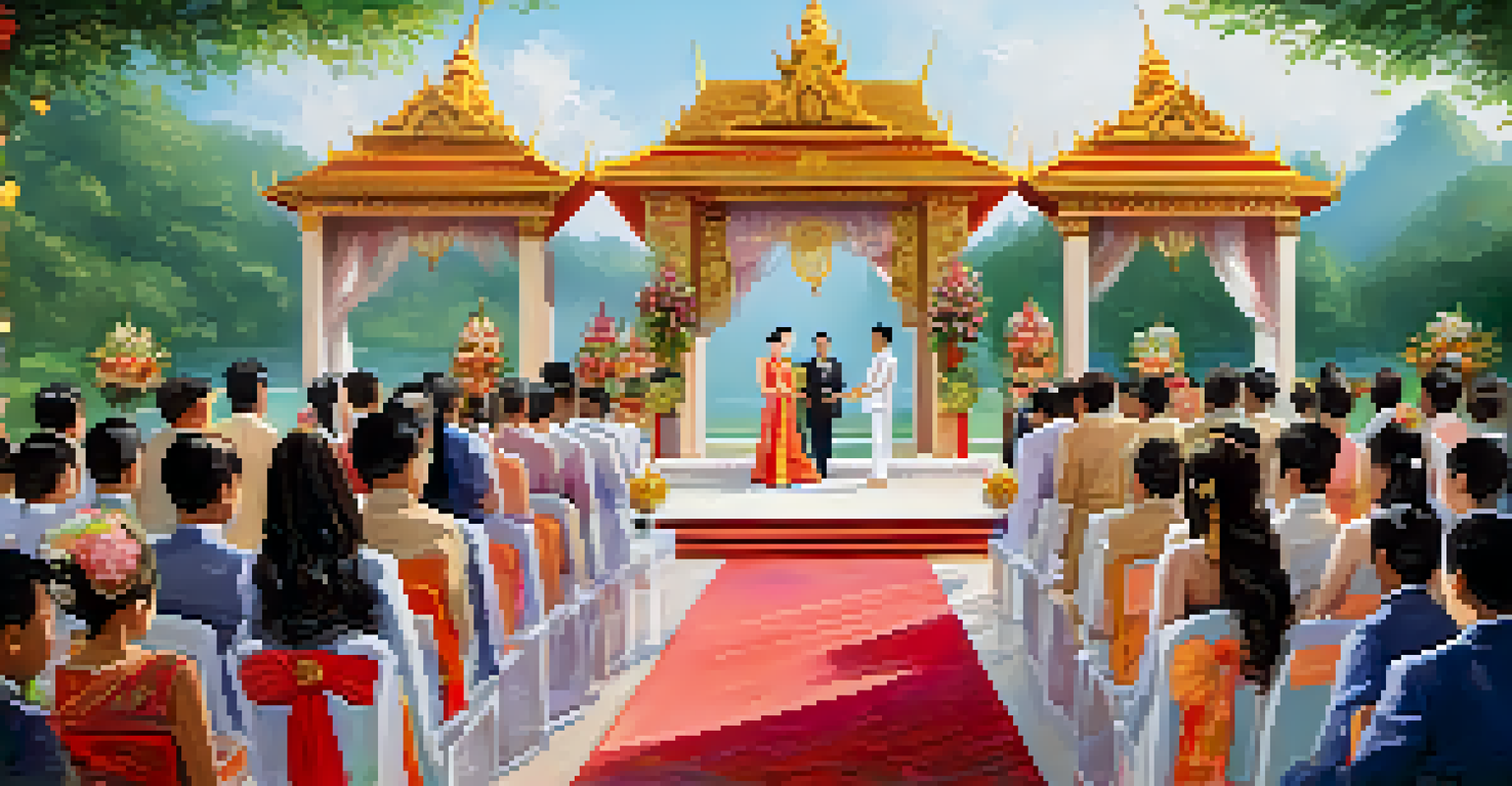Dress Code in Thailand: Attire for Different Occasions

Understanding Thailand's Culture and Dress Code Basics
Thailand is a country rich in culture and tradition, which is reflected in its dress codes. Understanding these codes is essential for anyone visiting or living in the country. Respect for local customs is paramount, and attire often signifies respect for the culture and its people.
Dress is an expression of who you are. It can convey your thoughts, feelings, and values without the need for words.
Generally, the Thai people dress modestly, with an emphasis on neatness and appropriateness. This means that clothing should not only be clean but also suitable for the occasion. Whether you’re visiting temples or attending social gatherings, adhering to the right dress code will help you fit in and show respect.
In larger cities like Bangkok, you may notice a mix of traditional and modern styles. However, when you venture into rural areas, traditional dress is more prominent. Understanding this blend can help you navigate social situations and make a positive impression.
Dress Code for Visiting Temples in Thailand
Visiting temples is a significant aspect of experiencing Thai culture, but it comes with strict dress codes. To show respect, visitors are expected to wear clothing that covers the shoulders and knees. This means no shorts, sleeveless tops, or revealing outfits when entering these sacred spaces.

A common solution is to wear lightweight, loose-fitting clothes that are both comfortable and respectful. For women, long skirts or dresses and blouses with sleeves are ideal. Men should opt for long pants and shirts with sleeves, ensuring they leave flip-flops and tank tops behind.
Respect Local Dress Codes
Understanding and adhering to Thailand's dress codes is crucial for showing respect to the culture and its traditions.
Additionally, some temples provide sarongs or wraps for those who arrive improperly dressed, but it’s always best to come prepared. By dressing appropriately, you not only comply with the rules but also enhance your experience as you explore the spiritual heart of Thailand.
Casual Attire for Everyday Activities
When it comes to everyday life in Thailand, the dress code is generally casual and comfortable. Light fabrics are favored due to the warm climate, with breathable materials like cotton or linen being popular choices. This allows for comfort while navigating the bustling streets or enjoying outdoor activities.
When you respect the culture of another people, you open the door to understanding their world.
For men, shorts and t-shirts are perfectly acceptable for casual outings. Women can opt for sundresses or shorts with casual tops. The key is to keep it simple and functional, allowing you to blend in with the local lifestyle while staying cool.
That said, while casual is the norm, it's still important to avoid overly revealing clothing. This helps maintain a sense of modesty and respect for the local culture, allowing you to enjoy your time without drawing unwanted attention.
Business Attire in Professional Settings
If you're planning to work or attend business meetings in Thailand, understanding the professional dress code is crucial. Business attire is typically formal, reflecting respect and professionalism. For men, this often means a suit and tie, while women should opt for tailored dresses or suits.
In many workplaces, even the hottest days might find employees in long sleeves and dress shoes. It’s advisable to choose breathable fabrics to remain comfortable while looking polished. This attention to detail in your attire can significantly impact how you're perceived in a business context.
Appropriate Attire for Temples
Visitors to Thai temples should wear clothing that covers shoulders and knees to honor the sacredness of these spaces.
Remember, first impressions matter, especially in a professional setting. Dressing appropriately demonstrates your commitment to the role and respect for your Thai colleagues, paving the way for positive working relationships.
Formal Attire for Weddings and Ceremonies
Attending a wedding or traditional ceremony in Thailand calls for formal attire that reflects the significance of the occasion. Men should wear suits, while women can choose elegant dresses or traditional Thai outfits. The goal is to look polished and presentable, honoring the event's importance.
Traditional Thai clothing, such as the 'chut thai' for women or a 'sangthong' for men, can be a wonderful way to embrace the culture. These garments are not only beautiful but also show respect for local customs. If you're unsure about what to wear, don't hesitate to ask the hosts for guidance.
Colors also play a significant role in Thai ceremonies, with specific hues symbolizing different meanings. For example, wearing white at weddings is typically reserved for the bride. Therefore, being mindful of color choices can help you navigate social nuances while ensuring you fit in beautifully.
Beachwear and Resort Attire in Thailand
Thailand is famous for its stunning beaches, making beachwear an essential part of your travel wardrobe. When lounging at a resort or enjoying a day by the sea, feel free to don swimsuits, sarongs, and cover-ups. However, it's important to remember that these outfits are generally reserved for beach areas.
While you can wear your swimsuit at the beach, it’s advisable to cover up when leaving the beach area. This means putting on a shirt or sundress and some footwear before heading to nearby restaurants or shops. This practice shows respect for local customs and helps you blend in with other beachgoers.
Seasonal Clothing Choices
Being mindful of Thailand's varying climate across seasons can enhance comfort and enjoyment during your visit.
Additionally, don’t forget to protect yourself from the sun. Wide-brimmed hats, sunglasses, and sunscreen are must-haves for those long days at the beach. By dressing appropriately, you can fully enjoy the beauty of Thailand's coastal treasures.
Seasonal Attire Considerations in Thailand
Thailand's climate can vary significantly between seasons, so it's essential to consider the weather when planning your wardrobe. The hot season, typically from March to May, calls for light, breathable fabrics to keep cool. Think airy dresses, shorts, and sandals to navigate the heat comfortably.
During the rainy season, which runs from June to October, it’s wise to have a lightweight rain jacket or poncho on hand. Waterproof footwear can also be a game-changer when dealing with sudden downpours. Opt for quick-drying materials to ensure comfort during unexpected weather changes.

Finally, the cooler months from November to February are more pleasant, allowing for versatile layering. Light sweaters or long-sleeve tops can be paired with lighter bottoms, making it easy to adjust to fluctuating temperatures. Being mindful of the seasons will enhance your experience in Thailand.